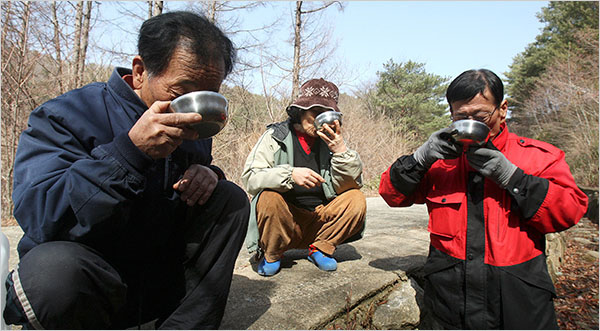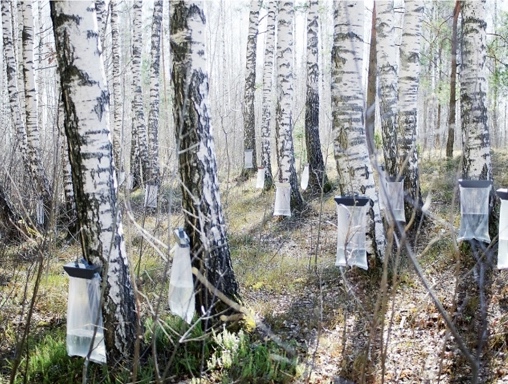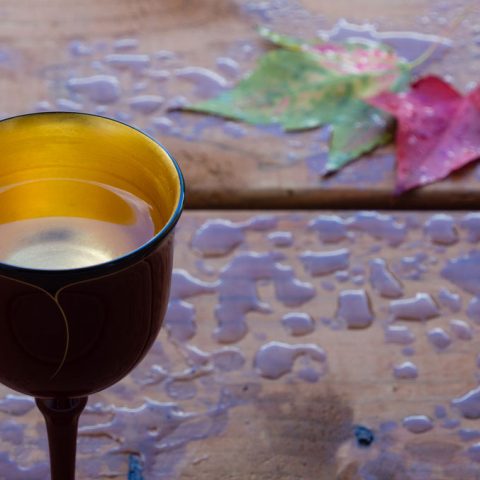Making Sweet Water Instead of Waste
If you enjoy coconut water, as we do, you may also want to look for and try some tree water. Also called “sweet water”, and “sap on tap”, tree water is growing in popularity and can now be found in health food and specialty stores as well as on Amazon.
Some of the commercially sold tree water is the runoff water from the syrup extraction process. With the laborious maple syrup boiling process, the sap is reduced to 1/40th of its original volume!! So… funneling the tree water into bottle to sell as sweet water or tree water is an excellent conservation of this precious tree elixir.
The most popular of the tree waters is currently birch, which is also used in cosmetic products.
Tree Water – a Health Elixir
Tree water is very different from syrup. It has an earthy refreshing flavor with sometimes just a hint of sweet. In fact, tree water is traditionally cast off in the gallons in the syrup distillation process per quart. One tree water company got started when the founder was disturbed to see the amount of tree water that was wasted during the maple syrup distillation process.
That was the beginning of Asarasi.
About Asarasi Tree Water Company
Asarasi (Ah-Sir-Ah-See) is Latin for Maple and here’s the origin synopsis from their website.
“Looking for a warm, fun activity to do with his daughter in the middle of a Vermont winter, Founder Adam Lazar decided to attend a maple syrup open house. As the farmer went through the production process, Adam witnessed him pouring thousands of gallons of pure water down the drain. After talking about it with the farmer, it was realized that maple producers use only 3% of the saps they collect for syrup and maple products. The remaining 97% is pure tree water that is not utilized and discarded. The idea was born that that this was a new source of incredibly pure water that had never been “tapped”!“
SOURCE: Asarasi.com
Tree water tastes clean with a refreshing earthy flavor and the occasional hint of sweet.

Tree Water Businesses
If you’re looking into home businesses you can do from your homestead, you may be interested in reading more on this. We found it intriguing, and while we don’t expect to go into the tree water business… you never know, and at the very least, tree water is another benefit to enjoy from our own trees!
By Brian Barth on Modern Farmer[1]https://modernfarmer.com/?s=maple+entrepreneurs
A new wave of maple entrepreneurs are skipping the laborious syrup boiling process—where sap is reduced to 1/40th of its original volume to create the beloved pancake dressing—and marketing the pure watery sap as a health drink instead.
The first maple water companies emerged over the last few years in Canada, but the idea has now infiltrated the American market. The drink is primarily found in health food stores in New England, but distribution is ramping up and this year’s maple water harvest should hit stores across the country in the coming months.
You may enjoy this clip from Dragon Den featuring the entrepreneurs of Seva Maple Water.[2]https://business.financialpost.com/2015/01/26/seva-maple-waters-dragons-den-deal-in-limbo-as-treliving-chilton-walk-away/?__lsa=7dd5-87ccThis is where we learned of the anticipated growth into a billion dollar industry by 2025.
If you were ever stranded without water, tree tapping, is another survival skill to know.
Tree Water Health Benefits
Europe and Asia have used tree water as a health elixir for centuries. In South Korea, it’s traditional to drink maple water, called Gorosoe.
Good for the Bones
Excerpt from the New York TImes article: Drinks Are on the Maple Tree, by By
HADONG, South Korea — At this time of year, when frogs begin stirring from their winter sleep and woodpeckers drill for newly active insects, villagers climb the hills around here to collect a treasured elixir: sap from the maple tree known as gorosoe.
For centuries, southern Korean villagers like Mr. Park have been tapping the gorosoe, or “tree good for the bones.”
Unlike North Americans who collect maple sap to boil down into syrup, Korean villagers and their growing number of customers prefer the sap itself, which they credit with a wide range of health benefits.
In this they are not alone. Some people in Japan and northern China drink maple sap, and birch sap has its fans in Russia and other parts of northern Europe. But no one surpasses southern Koreans in their enthusiasm for maple sap, which they can consume in prodigious quantities.[3]https://www.nytimes.com/2009/03/06/world/asia/06maple.html?_r=0

Birch Tree Water Benefits
There doesn’t appear to be definitive American studies on the nutritive or medicinal benefit of birch and other tree waters, however it has been used therapeutically for centuries in Europe and the East. Knowledge of the vitamins, minerals amino acids and other beneficial nutrients are enough to tell us that this simple sap water delivers more than water.
Low in calories and sugar, birch water is high in nutrients like magnesium and manganese, phosphorus, potassium, folic acid, vitamin C, and copper. Birch water also provides small amounts of amino acids and large amounts of polyphenol antioxidants, which help fight oxidative stress in your body.
One 10.2-ounce (300-ml) bottle contains:
- Calories: 9
- Carbs: 3 grams
- Sugar: 3 grams
- Calcium: 2% of the Daily Value (DV)
- Magnesium: 95% of the DV
- Manganese: 130% of the DV
- Zinc: 3% of the DV
NUTRITION RESOURCE: Healthline.com
If you have certain plant and tree allergies, it may be that birch water may actually help alleviate your allergic reactions. Of course you need to proceed with caution, as did Petra Ossowski Larsson. [4]https://www.cybis.se/craft/birch/
Birch tree sap or birch tree water as it’s more commonly called commercially, is also associated with detoxing the kidneys and liver and flushing toxins from the body.
Nutritional and Medicinal Uses
From Wikipedia.com
Birch sap contains heterosides (betuloside and monotropitoside), amino acids including glutamic acid, as well as minerals, enzymes, proteins, betulinic acid and betulin, antioxidants, sugar (xylitol, fructose and glucose) and vitamins B & C.
Birch sap is commonly known for its detoxifying, diuretic, cleansing and purifying properties. Heterosides present in birch sap release methyl salicylate by enzymatic hydrolysis which is analgesic, anti-inflammatory and diuretic. The activation of diuresis helps eliminating organic wastes such as uric acid and cholesterol. Birch sap is also known for helping with joint and bone health, loss of hair, arthritis, and weight loss, as well as hyperuricemia, hypercholesterolemia and to treat kidney stones.[5]https://en.wikipedia.org/wiki/Birch_sap

Harmless Tapping of Tree Sap
Naturally, some of us are tree lovers concerned about any possible harm or damage to the trees. Fortunately tree tapping is relatively harmless if done right.
As we wrote on one of the Gardens All Facebook threads:
“Like you, we LOVE trees. Live deeply amongst them in the woods, and built our home by hand cutting only what absolutely had to be cut to build, then of course used that wood for heating. So we’re with you in love of trees and compassion for all living things.
But there is another side to trees. Trees are also a plant, essentially, and serve in so many ways. One of the many gifts of trees is as crops, of which there are many different kinds.
With the syrup and tree water industry, while a “wound” is created in the trunk, studies show[6]https://www.uvm.edu/~pmrc/wilmot_taphole.pdf that that wound is akin to a wound in our body. It develops “scar tissue” around it, then carries on as normal.
Relative to the sapping of its resources… if we sweat and get dehydrated, we drink more water. Similarly, as tree water is extracted, the tree simply pulls more water from the soil through its own filtering system which then contributes more nutrients to the water.”
WISDOM FROM NATURE: Trees teach us how to adapt: they just keep on growing, no matter what!
The study cited and linked here says:
For sugaring [and tree water] to be a viable industry, it must be sustainable and not lead to the decline of our trees. Drilling a taphole does make a wound, but with proper tapping procedure and sensible tapping guidelines, (as can be found in the new North American Maple Syrup Producer’s Manual),[7]https://www.agmrc.org/media/cms/Maple1_74116E2C32052.pdf we can be assured that these wounds are minor, and that the tree will be able to repair itself, or can function well without the small volume of wood with non-functional vessels. With proper care in sapling collecting, as well as in many other aspects of forest management, our maples trees can last for many generations of future sugar makers.[8]https://www.prvnimiza.cz/wp-content/uploads/2016/07/wilmot_taphole.pdf
For examples of excessive tapping to avoid, you may be interested in this research by the Forest Service US Department of Agriculture Northeastern Forest Experiment Station, Broomall, PA.[9]https://www.nrs.fs.fed.us/pubs/gtr/gtr_ne47.pdf

With proper care in sapling collecting… our maples trees can last for many generations of future sugar makers.
~Farming, the Journal of Northeast Agriculture, February, 2009
And, from Judy of the Woods:
“The easy way to tap a tree (thanks, Rob, for this great tip) is by simply cutting, or even breaking off the end of some thin branches. Put the branches into the neck of a bottle, tie the bottle to the branches and gently weigh them down to make sure the bottle hangs in as upright a position as possible. Branches want to point upwards. You can tie a small log or other weight to the branches, tie them to vegetation below or lean a long stick of the right weight onto the branches to make them bend down.
There is no need for any sealing after the tapping. The small twigs will heal over by themselves. This method is suitable for any tree where the branches are easy to reach, and can be done on younger trees. From JudyOfTheWoods.net [10]https://www.judyofthewoods.net/forage/tree_sap.html
We Tapped Birch, Maple and Sycamore – Lightly
We tried tapping birch, maple, and sycamore trees on our land and got the most from the trunks of our birch trees. Another method tried was something we read about that might save piercing the trunk, however results were minimal. But again, if you were stranded without water, it could still be a life saver.
Bag-on-a-Limb Method
We tried tethering sturdy plastic bags to the end of snipped limbs to see what would drain out. We did get a little bit of fresh liquid from some, and can see how that would work with a little more pruning, so it could be a great thing to do when pruning a tree.
Similarly, if you were stranded in the woods and needed water, you could snap off the end of a thin limb and likely accrue enough tree water to survive, especially if you didn’t have tools or vessels for piercing and capturing larger amounts from a trunk.
We also tapped with a spout. The birch by the stream gushed water from the spout and it was hard to seal it back. So we felt really bad that the tree continued to “weep”, even after our bottle was filled.
We looked into tree wound sealants but the extension service advice was to allow the wounds to heal naturally. The trees know how to heal in the same way our skin does. Just remember to drill the smallest clean hole and not too deep.
How Did it Taste?
Scarcely sweet, but very clean and refreshing. There’s something about it that feels vital and nourishing in the same way fresh garden vegetables do. Would we do it again? Yes, in the spring, we will tap a tree at a time for some fresh spring elixir, so long as we can continue to determine that there’s no harm to the trees.
As for a viable business…? It certainly seems feasible, and these are already being sold in retail stores and on Amazon. However, it may never become the phenomenon that coconut water has become because it takes a lot more to create the same amount of liquid tapping a tree as it does from a coconut. Plus coconuts yield their liquid without sapping the tree.
Since there’s more involved in harvesting tree water, it will necessarily remain more expensive, which could prevent it from ever catching on with the masses. But meanwhile, if you have a few trees on your property, you might enjoy giving it a go and tapping a tree next spring.
If you’re into hiking, camping, prepping and survival preparedness, you’ll want to place a tree spout in your bug out bag or hiking backpack, just in case. If you’re ever stranded in a forest in need of water, tapping a tree could save you. For that matter, also a great idea to have a Life Straw handy for filtering water to drink.
Tree water is just as hydrating as coconut water, yet it has only a quarter of the amount of sugar.
~NewFoodMagazine.com
Is Tree Tapping Harmful?
But is tapping trees is harmful to the tree…? Well…
- Is milking cows harmful to the cow?
- Is collecting honey harmful to the honey bees?
- Has collecting maple syrup harmed the sweet maple tree population?
Apparently, with this as with most things, if it’s done responsibly, which includes during the best times of the years (late winter/early spring before the trees leaf out), then there’s no harm to the tree.
For more specifics on maple tree tapping facts, including the maximum number of taps per size of tree, you can find that in this article on tree tapping.
“Tapping birches doesn’t harm tree health as long as it is done properly.”
~TheGuardian.com
For more on this, you may enjoy this article on how to tap your own maple trees.
Wishing you the best health for you and your trees.
I’m LeAura Alderson, a garden, herb and plant enthusiast with a passion for discovering the many edible and medicinal benefits of the plants all around us, including the weeds! I’m a writer, editor and media publisher for our family of websites.
While I was certified in fitness and life coaching, I am NOT a health practitioner. However, I’m a lifelong health enthusiast, with a keen interest in healthy, organic foods and making home remedies and the content we share is from our own experience and usage as well as that extracted from scientific research so that you can explore further on your own.
Always seek the advice and guidance of your health practitioners first and foremost.
As a family we’re steadily expanding our gardening, experimentation and knowledge around all things gardening, edible landscaping, fresh organic foods and self sustainability with farming in our future. I also own and manage iCreateDaily.com, a site all about transformation through creation, and the power of positivity, optimism and mindset.
References

